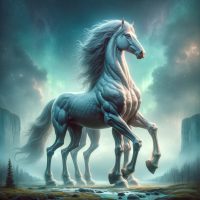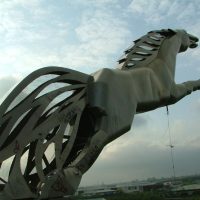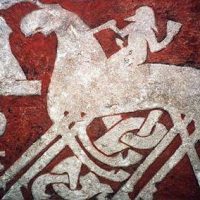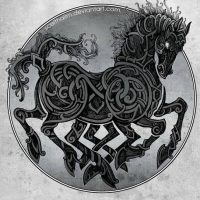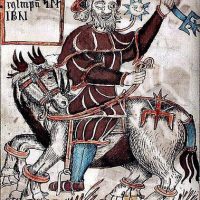Sleipnir : The 8 legged Horse
Listen
At a glance
| Description | |
|---|---|
| Origin | Norse Mythology |
| Classification | Animals |
| Family Members | Loki (Father), Svadilfari (Mother) |
| Region | Iceland, Denmark, Norway, Finland |
| Associated With | Speed, Size |
Sleipnir
Introduction
Sleipnir, an emblem of potency and otherworldly essence, occupies a significant place in Norse mythology. Far from ordinary, this steed boasts eight legs, rendering it a singular and formidable being. Its presence within the Norse pantheon evokes unparalleled wonder and admiration, serving as a testament to its extraordinary swiftness and mysterious origins. From its enigmatic form to its pivotal role in ancient narratives, Sleipnir emerges as a symbol of supremacy, transcendence, and the enduring connection between divinity and the natural world. This unique and captivating entity, celebrated as Odin’s eight-legged companion, transcends conventional equine attributes. Referred to as “The Sliding One” or “Slippy” in the Old Norse lexicon, Sleipnir represents the epitome of equine prowess and velocity across all realms of existence.
Physical Traits
Sleipnir, a magnificent equine specimen, defies conventional expectations with his imposing physique boasting not four but eight sturdy legs. These additional limbs, emerging from both his shoulders and haunches, augment his already impressive stature, creating an image that is both captivating and eerie. His coat, reminiscent of a brooding thundercloud, cloaks him in a veil of mystery, while his mane and tail cascade like dark rivers, adding to his enigmatic allure.
The symbolism behind Sleipnir’s extra limbs remains a subject of fascination and interpretation. Some speculate that they signify his ability to transcend the boundaries between realms, while others attribute them to his unmatched speed and agility. Regardless of their significance, Sleipnir’s dark-as-night coat exudes an ethereal radiance, hinting at his divine lineage. His eyes, deep and profound, seem to harbor the wisdom of ages, reflecting the mysteries of the cosmos as he gallops across the heavens, his mane billowing like a celestial tapestry.
Unlike his earthly counterparts, Sleipnir’s unique attributes set him apart as a celestial marvel. His imposing size, coupled with his eight legs, endows him with unparalleled speed and mobility, allowing him to traverse the vast expanse of the nine realms with effortless grace. Whether depicted as grey, black, white, or a blend of shades, Sleipnir’s presence evokes a sense of awe and reverence, embodying the essence of divine power and mystique within Norse mythology.
Family
Sleipnir’s origins intertwine with the fabric of Norse mythology, tracing back to the cunning trickster god, Loki, and the formidable stallion, Svadilfari. Loki, renowned for his mischief and shapeshifting prowess, assumed an unconventional role in Sleipnir’s conception. Some narratives weave a tale of Loki’s transformation into a mare to entice Svadilfari, while others hint at a simpler act of theft. Regardless of the specifics, Sleipnir’s birth is veiled in intrigue, blending Loki’s guile with Svadilfari’s sheer might.
Despite his unorthodox lineage, Sleipnir’s acceptance among the Norse gods was unwavering. Born of a union that defied conventional boundaries, Sleipnir embodied a fusion of Loki’s cunning and Svadilfari’s strength. This unusual combination endowed him with a noble spirit, earning him a place of honor among the deities of Asgard. His presence symbolized the resilience and adaptability inherent within Norse mythology, where alliances are forged amidst the tumult of divine machinations.
Sleipnir’s lineage serves as a testament to the intricate web of relationships that define Norse cosmology. Born of gods and giants, his existence bridges the realms of Asgard and Jotunheim, embodying the duality of his heritage. Despite the chaos that often characterizes divine affairs, Sleipnir stands as a beacon of stability and hope, his eight-legged form embodying the resilience of the Nine Realms amidst the tumultuous forces that shape their destiny.
Other names
Sleipnir, the illustrious steed of Norse mythology, bears a myriad of epithets that reflect the diverse facets of his character. Among these, “The Sliding One” or “Slippy” in Old Norse, offers a glimpse into his swift and agile nature. The name “Sleipnir” itself is believed to stem from the fusion of Old Norse terms “slei” and “pnir,” embodying the essence of ‘slippery’ or ‘gliding.’ This linguistic evolution encapsulates Sleipnir’s reputation as a creature of unparalleled speed and fluidity.
In the vast tapestry of Norse lore, Sleipnir’s aliases abound, each painting a unique portrait of his essence. Beyond his familiar title, Sleipnir is affectionately referred to as “Glaðsheimr,” conjuring images of joy and revelry in the celestial halls of the gods. This alternative designation underscores Sleipnir’s cherished role as Odin’s faithful companion, a steadfast presence amidst the grandeur of Asgard.
Sleipnir’s enigmatic persona extends to the epithets bestowed upon him, such as “Greyfell” or “Greidhoppr,” evoking imagery of his coat’s hue and the ephemeral grace of his movements. Likewise, “Svaðri,” meaning “Mane of Plenty,” hints at his lineage, suggesting a connection to the resilience and strength inherent in the giants of Jotunheim. These names serve as tributes to Sleipnir’s enduring legacy, perpetuating the mystique that surrounds this celestial equine marvel.
Powers and Abilities
Sleipnir, hailed as “the best among horses,” embodies unparalleled prowess and versatility in Norse mythology. Renowned for his unmatched speed, strength, and courage, he surpasses all equine counterparts in feats of athleticism and resilience. From galloping across land to soaring through the skies and navigating treacherous waters, Sleipnir’s abilities transcend the boundaries of conventional horsehood.
As Odin’s faithful steed, Sleipnir serves as more than a mere mode of transportation; he is a conduit for divine exploration and cosmic adventure. Legends recount his lightning-fast gallops across the heavens, carrying the Allfather to distant realms and untold adventures beyond mortal comprehension. Yet, Sleipnir’s prowess extends beyond physical attributes; as the companion of the highest deity in the Norse pantheon, he possesses an innate understanding of the cosmos and the intricate web of realms that comprise it.
Sleipnir’s most celebrated attribute is his phenomenal speed, rendering him the swiftest of all horses across the Nine Realms. His eight legs not only grant him unparalleled velocity but also afford him access to the farthest reaches of existence, including the forbidding realm of Hel. Coupled with his reputed intelligence and ability to comprehend human speech, Sleipnir emerges as a formidable ally in the divine struggles that shape the fate of gods and mortals alike.
Modern Day Influence
In contemporary times, Sleipnir’s presence persists in Icelandic folklore, where he is credited as the architect of Ásbyrgi, and across various artistic mediums, including literature, software, and maritime vessels. Symbolizing attributes such as speed, agility, and strength, Sleipnir remains a potent source of inspiration for artists, writers, and modern interpretations, leaving an indelible mark on the tapestry of Norse mythology.
Despite belonging to an ancient pantheon, Sleipnir maintains a pervasive influence in the modern world, manifesting in diverse forms of media ranging from literature and film to video games. Revered as a symbol of formidable power and otherworldly prowess, Sleipnir often features prominently in portrayals of myth and legend, embodying the spirit of adventure and exploration.
Moreover, Sleipnir’s legacy transcends the realms of fiction, permeating everyday language and culture. Phrases like “riding Sleipnir’s back” evoke moments of exhilarating speed or excitement, while discussions of divine lineage and mythical creatures frequently invoke his name. As Sleipnir’s legend endures in modern culture, his iconic image continues to inspire artists, writers, and audiences alike, serving as a timeless testament to the enduring allure of Norse mythology.
Related Images
Frequently Asked Questions
What is lorem Ipsum?
I am text block. Click edit button to change this text. Lorem ipsum dolor sit amet, consectetur adipiscing elit. Ut elit tellus, luctus nec ullamcorper mattis, pulvinar dapibus leo.
What is lorem Ipsum?
I am text block. Click edit button to change this text. Lorem ipsum dolor sit amet, consectetur adipiscing elit. Ut elit tellus, luctus nec ullamcorper mattis, pulvinar dapibus leo.
What is lorem Ipsum?
I am text block. Click edit button to change this text. Lorem ipsum dolor sit amet, consectetur adipiscing elit. Ut elit tellus, luctus nec ullamcorper mattis, pulvinar dapibus leo.
What is lorem Ipsum?
I am text block. Click edit button to change this text. Lorem ipsum dolor sit amet, consectetur adipiscing elit. Ut elit tellus, luctus nec ullamcorper mattis, pulvinar dapibus leo.
What is lorem Ipsum?
I am text block. Click edit button to change this text. Lorem ipsum dolor sit amet, consectetur adipiscing elit. Ut elit tellus, luctus nec ullamcorper mattis, pulvinar dapibus leo.

